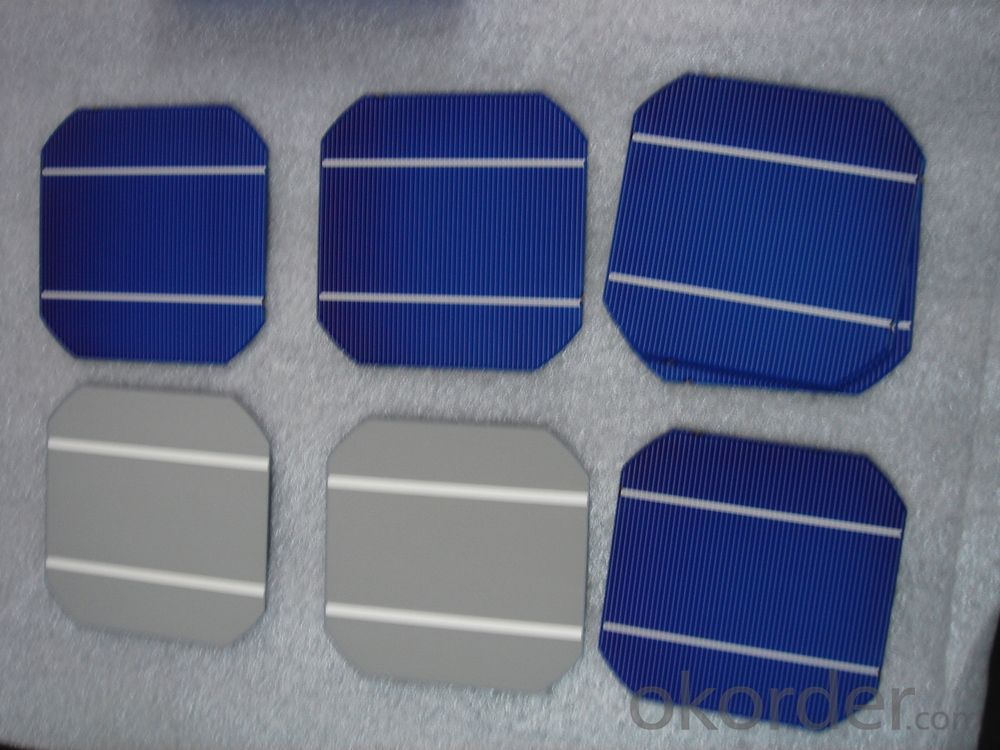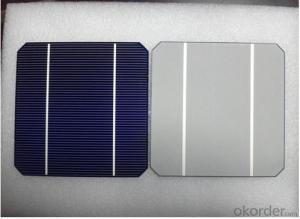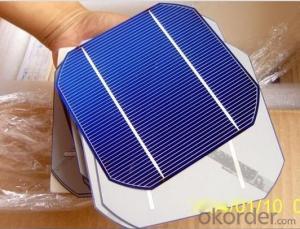125 Mono Solar Cell 5 Inch Efficiency 2.85W-3.5W
- Loading Port:
- Shanghai
- Payment Terms:
- TT or LC
- Min Order Qty:
- 500 pc
- Supply Capability:
- 10000 pc/month
OKorder Service Pledge
OKorder Financial Service
You Might Also Like
| Quick Details | |||||
| Material: | Monocrystalline Silicon | Bus Bar: | 2 | Grade: | A |
| Size: | 125*125mm | Max. Power: | 2.85w-3.5W | Efficiency: | 18.6-22.87 |
| Packaging & Delivery | |
| Packaging Detail: | Typical package for one box is 1,000 cells.These cells are sealed in paper boards every 100 PCS.Gross weight per unit box shall be around 16kg |
5'' High Efficiency Mono Solar Cell 125*125 mm



Our Advantage
Reason:
We enjoy exclusive channel to get solar cells at more competitive price from Sunpower,Neo solar,Motech,Gintechetc.
We signed long term purchase contract with Taiwan tier 1 solar cell manufacturers,including but not limited to Neo solar,Motech,Gintech,AUO,then we can purchase unsorted solar cells in bulk from them and sort these unsorted solar cells into same efficiency,same pattern,same color by our own QA team. We call them Grade A-.
Quality :
These sorted solar cells have same electrical performance with Taiwan Grade A solar cells,only difference is the negligible superficial defect.
We can guarantee that they are better than grade A solar cells from tier 1 solar cell manufacturers in China mainland.
Description
1.Mechanical Specification:
Product Mono-crystalline silicon solar cell
Dimension 125 mm x 125 mm ± 0.5 mm
Thickness 200 μm ± 30 μm
Front 1.4mm bus bar(silver),blue anti-reflecting coating(silicon nitride)
Back 2.0 mm wide soldering pads(silver) Back surface field (aluminum)
2.Electrical Properties
| Efficiency (%) Pmpp (W) Vmpp(V) lmpp (A) Voc(V) lsc(A) |
| 19.40-19.50 3.01 0.54 5.61 0.64 5.93 |
| 19.30-19.40 2.99 0.54 5.58 0.64 5.92 |
| 19.20-19.30 2.97 0.54 5.55 0.64 5.92 |
| 19.10-19.20 2.96 0.53 5.54 0.64 5.90 |
| 19.00-19.10 2.94 0.53 5.51 0.64 5.89 |
| 18.90-19.00 2.93 0.53 5.50 0.63 5.87 |
| 18.80-18.90 2.91 0.53 5.47 0.63 5.86 |
| 18.70-18.80 2.90 0.53 5.46 0.63 5.85 |
| 18.60-18.70 2.88 0.53 5.43 0.63 5.84 |
| 18.40-18.60 2.85 0.53 5.40 0.63 |
Packaging & Shipping
1. Payment term: T/T in advance (W/U for sample order)
2. Lead time: It depends on your quantity. Usually we will send sample within 1-3 working days.
3. Shipping will be made via EMS, DHL, TNT, UPS, Air, Sea etc. shipment
4. Others: If you have special specifications and requirements, we will do different offer as you required.
Our Services
Pre sale:
1.Our sales representative and engineer work together to answer your questions and offer solution for free
2.We choose the best product for you to make sure it worth its real value
3.We design the best solution with good perfomance for you,manwhile save every cent of your money.
After sale:
We can change broken solar cell for you or compensate for your lost.
Solar cells are electronic semiconductor components, by means of which sunlight can be converted into electric energy. The semiconductor body can consist, for instance, of silicon or a III-V compound such as gallium arsenide and is provided on its front side facing the radiation source with a p-n junction of large area by means of diffusion.
A method for manufacturing solar cells comprising growing semiconductor whiskers on a substrate, comprising:
(a) Providing a substrate which favors growth or germination of whiskers;
(b) Depositing a plurality of localized areas of an agent in which the semiconductor material is soluble;
(c) Growing whiskers of said semiconductor material by means of the Vapor Liquid Solid (VLS) method at said areas;
(d) Doping the whiskers with one of a p or n doping material; and
(e) Subsequently thereto doping the surface region of said whiskers up to a depth which approximately corresponds to the diffusion length of the charge carriers pairs with the other of a P or n doping material.
Estimating the manufacturing cost of purely organic solar cells
we estimate the manufacturing cost of purely organic solar cells. We find a very large range since the technology is still very young. We estimate that the manufacturing cost for purely organic solar cells will range between $50 and $140/m2. Under the assumption of 5% efficiency, this leads to a module cost of between $1.00 and $2.83/Wp. Under the assumption of a 5-year lifetime, this leads to a levelized cost of electricity (LEC) of between 49¢ and 85¢/kWh. In order to achieve a more competitive COE of about 7¢/kWh, we would need to increase efficiency to 15% and lifetime to between 15–20 years.
Manufacturing Solar Cells
First, silicon raw material is melted and re-cast to remove impurities. The cast silicon is then stabilized in its multicrystalline form. These castings, called "ingots," are then cut into blocks. Next, the ingots are sliced into wafers.( Depending on the type of silicon used, p-type or n-type silicon wafers may be produced). After layering the p-type or n-type wafers, the material is capable of generating electricity from sunlight. Electrodes are attached to the wafers to conduct the flow of electricity. This is called a photovoltaic cell, or "solar cell."
- Q:Can solar cells be used for powering wildlife tracking devices?
- Yes, solar cells can be used for powering wildlife tracking devices. Solar cells are a reliable and sustainable source of energy that can effectively power small electronic devices, including wildlife tracking devices. They can harness sunlight and convert it into electrical energy, providing a continuous power supply for tracking devices in remote locations where other power sources may be limited or unavailable.
- Q:Can solar cells be used on boats?
- Yes, solar cells can be used on boats. They are a reliable and efficient source of renewable energy that can power various electrical systems on board, including lighting, navigation equipment, and charging batteries. Additionally, solar cells are lightweight, durable, and environmentally friendly, making them an ideal choice for boating applications.
- Q:How do solar cells affect the electricity grid?
- Solar cells affect the electricity grid by injecting clean and renewable energy into the system. When solar cells generate excess electricity, it can be fed back into the grid, reducing the demand for electricity from traditional power plants. This helps diversify the energy sources and reduce carbon emissions. However, the intermittent nature of solar power can pose challenges to grid stability and require additional infrastructure investments for efficient integration.
- Q:Can solar cells be used in data centers?
- Yes, solar cells can be used in data centers. They can help offset the energy consumption of the data center by generating clean and renewable electricity. However, their effectiveness may depend on factors such as the size of the data center, available space for solar panel installation, and the amount of sunlight available at the location.
- Q:What is the impact of solar cells on job creation?
- Solar cells have had a significant positive impact on job creation. The rapid growth of the solar industry has created numerous job opportunities across various sectors, including manufacturing, installation, and maintenance. This has not only boosted employment rates but also led to the development of specialized skills and the creation of new businesses. Moreover, the shift towards renewable energy sources like solar power has the potential to further drive job creation as the demand for clean energy continues to increase.
- Q:Solar cell life for several years
- In physics called solar photovoltaic (Photovoltaic, photo light, voltaics volts, abbreviated as PV), referred to as photovoltaic.
- Q:What is the impact of dust and dirt on solar cell performance?
- Dust and dirt can significantly impact the performance of solar cells. When dust and dirt accumulate on the surface of solar panels, they reduce the amount of sunlight that reaches the cells, resulting in a decrease in energy production. The presence of dust and dirt also creates a layer on the surface, which can cause hotspots and increase the temperature of the solar cells, further reducing their efficiency. Regular cleaning and maintenance are essential to maximize the performance and lifespan of solar cells.
- Q:Can solar cells be used for powering remote oil and gas pipelines?
- Yes, solar cells can be used for powering remote oil and gas pipelines. Solar power offers a reliable and sustainable energy source that can be easily installed in remote locations. It provides a cost-effective solution for powering these pipelines, reducing the dependence on fossil fuels and minimizing the environmental impact.
- Q:Do solar cells work at night or in low light conditions?
- No, solar cells do not work at night or in low light conditions because they require sunlight to generate electricity.
- Q:What is the average lifespan of a solar cell in space?
- The average lifespan of a solar cell in space can vary depending on several factors such as the quality of the materials used, the level of radiation exposure, and the specific mission requirements. However, on average, solar cells in space can last anywhere from 10 to 25 years.
1. Manufacturer Overview |
|
|---|---|
| Location | |
| Year Established | |
| Annual Output Value | |
| Main Markets | |
| Company Certifications | |
2. Manufacturer Certificates |
|
|---|---|
| a) Certification Name | |
| Range | |
| Reference | |
| Validity Period | |
3. Manufacturer Capability |
|
|---|---|
| a)Trade Capacity | |
| Nearest Port | |
| Export Percentage | |
| No.of Employees in Trade Department | |
| Language Spoken: | |
| b)Factory Information | |
| Factory Size: | |
| No. of Production Lines | |
| Contract Manufacturing | |
| Product Price Range | |
Send your message to us
125 Mono Solar Cell 5 Inch Efficiency 2.85W-3.5W
- Loading Port:
- Shanghai
- Payment Terms:
- TT or LC
- Min Order Qty:
- 500 pc
- Supply Capability:
- 10000 pc/month
OKorder Service Pledge
OKorder Financial Service
Similar products
New products
Hot products
Related keywords




























